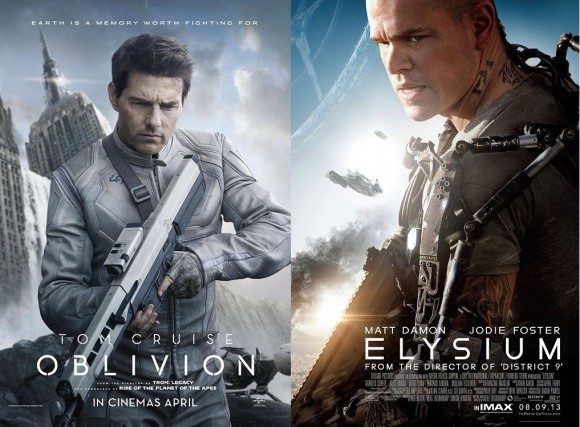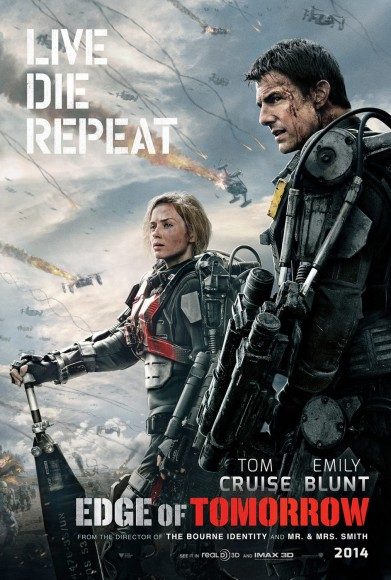Hollywood’s latest batch of post-apocalyptic science fiction action-dramas have placed the industry in a bit of a crisis. In spite of the criticism that Hollywood studios seem less willing than ever to greenlight original films of this sort – i.e. neither an adaptation of teen lit like The Hunger Games nor an otherwise specifically franchise-able property – there have been a steady stream of new sci-fi properties with a post apocalyptic twist. And at least on the surface, they sport the special combo of populist fun with high(er) brow concepts that made the exemplars of the genre so well-respected. Last summer, we encountered Joseph Kosinski’s Oblivion, Neil Blomkamp’s Elysium, and M. Night Shyamalan’s (really Will Smith’s) After Earth, each with a production budget well over $100 million. Unfortunately, these high-profile star vehicles crashed, with none of them breaking $100 million domestic or $300 million worldwide.
This year, Hollywood is once again attempting to excite us with the imminent deaths of everyone we ever knew or cared for with the likes of Transcendence, Edge of Tomorrow, and Godzilla. While we cannot expect the studios to fully abandon the post-apocalyptic genre, another year like 2013 could make them even more hesitant to give a hefty paycheck to filmmakers with a genuine (“risky” in studio speak) vision about our untimely ends. Whether or not this year’s films will break the downward trend requires them to avoid the mistakes of not-too-distant futures past.
The initial problem with last year’s informal trilogy actually had less to do with the movies themselves and more about their marketing. All came across as exactly the same film- even before they were released. Just look at the posters.
The ads showed Tom Cruise, Matt Damon, and Will Smith’s heir literal wandering alone across a desolate Earth, the kind of place they’re likely to come across a destroyed iconic landmark. These action ready, working class heroes (a mechanic, an ex-con, and a soldier, respectively) are forced into a quest to save someone and soon discover that the world they knew is not really the world they knew. To see one of these movies would be to see them all, and the uninspired marketing gave little reason to see any of them.
In practice, the similarities among the films became even more apparent. You got the sense that each filmmaker thought they were creating something special or unique, but lacked the content to back up their claim. Oblivion fell in love with its twists that any reasonably seasoned viewer could see coming from the first 30 minutes. Elysium seemed proud about its look at real world social issues such as class divisions, healthcare reform, and immigration, but failed to recognize how it was doing so in incredibly simplistic and stupid ways. (For example, subscribing to every rote stereotype of the vapid evil rich, such as their penchant for finger sandwiches and garden parties, and the plot-driving Magic Medical Mattresses going way beyond suspension of disbelief by curing a blown-off head.) Finally, After Earth gave us a story that thought it was saying something significant about familial bonds, courage, and (allegedly) Scientology, but instead gave us a painfully dull (and all around painful) performance from Jaden Smith as he spent most of the running time interacting solely with lame CGI creatures and his father’s voice. A potentially interesting psychological study about the real world Smiths to be sure, but not an interesting movie.
The three movies also featured an overwhelming tone of moroseness complete with the overused theme of sacrifice. The post-apocalypse need not be happy or colorful, but there is a significant difference between the desperate broodiness of Mad Max or the dystopian Blade Runner and the humdrum nature and passionless direction of the aforementioned films. Sweeping landscape shots are no substitute for real emotions. Taking yourself overly seriously without something to balance it out (eg. ultra-violence, a dark sense of humor, a charismatic lead, an innovative location) bores an audience and tires them out.
Look at 2013’s two commercial and critical post apocalyptic successes. Pacific Rim took its post-apocalyptic framework and brought to it larger-than-life fun. Guillermo del Toro’s palpable excitement and love for his creatures – robots, humans, and monsters alike – could be felt in every frame. Although Pacific Rim didn’t come close to being the huge hit people expected/wanted it to be, you heard positive things about it afterward. And of course, there was Gravity– another science fiction action-drama with star power. Its apocalypse may have been bound to its orbital context, but the focus on survival in a harsh and destructive environment makes it at least a spiritual sister to other end-of-the-world fare. Gravity made more than $700 million worldwide because director Alfonso Cuarón focused not on stars Sandra Bullock and George Clooney, but on the cinematic experience. From the get go, Gravity was an on-screen nightmare that utilized a variety of techniques to trigger the audience’s base emotions of pure fear and an overwhelming sense of insignificance.
In short, both Pacific Rim and Gravity made a point of immersing their audiences into their unique sci-fi worlds before trying to use that engagement to leverage anything more. The same can’t be said of the me-too flops of Oblivion, Elysium, and After Earth.
Back to this year’s crop. Of the three major big budget looks at the end of humanity arriving during the first half of 2014, there’s one – Edge of Tomorrow (June 6, 2014) – that looks closest in style to Elysium, Oblivion, and After Earth. On the surface, we have yet another artificially gritty movie about a dirty, obliterated Earth centered around a big star (Oblivion’s Tom Cruise) who runs around using futuristic weaponry. This time Cruise has a female sidekick (Emily Blunt)… which he also had in Oblivion (Olga Kurylenko). Finally, we get to the hook…respawning. Like a video game, every time Tom Cruise dies, he comes back to life with the opportunity to put things right that once went wrong.
Can this Starship Troopers-y Future War-set Groundhog Day capture the public’s hearts and minds or have we been burned too many times before? Obviously, it’s too early to make any definitive judgment. As of present, the best/only thing we have to go on is the marketing. The two trailers for Edge of Tomorrow actually indicate that the studio (in this case, Warner Brothers) is trying alternative approaches to differentiate it from last year’s flops.
The first trailer focuses almost exclusively on Tom Cruise and plays up the respawning mystery. With an electronic voice proclaiming “This is Not The End” on repeat, it does little to inspire confidence and once again seems like a bland experience filled with dark tunnels, unimaginative mechanized suits, boring fight sequences, and explosions to distract us from its lack of material.
The second trailer, on the other hand, explains the respawning concept from the outside rather than hiding it. More importantly, the tone of the trailer is slightly different. Emily Blunt becomes the equal of Tom Cruise; respawned Tom Cruise has some confidence rather than insecurity; and the relationship between Blunt and Cruise has at least a couple of humorous moments, as opposed to the dourness of our first introduction to this film.
Unfortunately, these differences only highlight that Edge of Tomorrow will probably follow the same path as its predecessors. Despite being dressed up with jokes, romance, and honesty, the trailer cannot avoid making the bulk of its footage underwhelming landscape shots, uninspired space military hardware, and unimpressive battle sequences. An abundance of CGI has cost the epic war its novelty, and Edge of Tomorrow‘s gimmick lacks the originality (in addition to Groundhog Day, there were also the television shows Tru Calling and Day Break that used it as its center, not to mention the countless science fiction shows that borrowed it for a single episode) necessary to overcome audience apathy.
Of course, Edge of Tomorrow is not entirely hopeless- no movie is until it actual hits theaters. Advertisements cannot capture all the qualities of a film or accurately represent the viewing experience, nor would you want them to. Edge of Tomorrow doesn’t even need to be a good movie as long as it is a unique one. Nevertheless, the material we currently have to work with fails to inspire anything other than “been there-didn’t even bother doing that the first time.”




